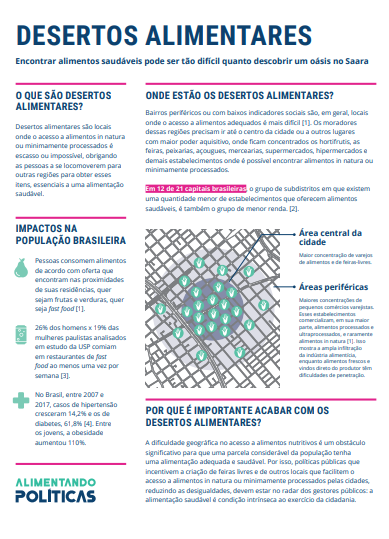Is it easy to buy food anywhere in the city?
The right to adequate and healthy food is guaranteed by the Federal Constitution. However, even if it is a law, is it easy to find and buy fresh or minimally processed foods? A survey conducted in Jundiai, a city in the country side of the state of São Paulo, brings the answer to this question. Learn more.
Researches
Institution
Published
Peripheries have fewer food retail business points
To combat the growth of obesity and other related diseases, such as diabetes, high blood pressure and various types cancer, it is necessary – amongst other measures – that people are able to easily consume healthy foods that have come directly from nature (fresh food), such as fruits, vegetables and greens, or that have been minimally processed, such as corn flour, rice, beans, amongst others. However, researches in Brazil and other countries show that the access to these types of food is not as simple as it seems. A study that was carried out in Jundiai, a city in the country side of the state of São Paulo (SP), shows that residents of the periphery [or] outskirts of urban areas are the most harmed. In order to consume and have access to different types of food, they need to go to the center of the city, where supermarkets, hypermarkets, street farmers markets and butcher shops are concentrated, and where the people with the highest purchasing power live.
Methodology
960 food retail business points analyzed
In order to verify how the food supply in a city is distributed, researchers from the University of São Paulo (USP) mapped the entire food retail businesses of the city of Jundiai and crossed this information with the social and economic characteristics of the population, such as schooling indexes , average monthly income and the number of residents per household. A total of 960 food retail business points were analyzed – 46.5% of small grocery stores, 16.7% bakeries, 4.7% super and hypermarkets, and 4.8% domestic production, family or direct agriculture producers.
Conclusion
The lack of variety of places that offer fresh or minimally processed foods in peripheral [or] outskirts neighborhoods with low social indicators can hinder access to healthier foods for a large part of the population. The mapping developed by researchers can be used as a basis for public policies that encourage a better distribution of food trade by cities, reducing inequalities. In addition, the study can help leverage existing projects that facilitate citizens’ access to adequate food.
Scientific article
Support material
Inspirational laws and projects
Successful cases
-

Produtor na Praça, Pesca Econômica, Circuito das Frutas nos Terminais e Varejões Noturnos (Producer in Public Squares, Economic Fishing, Fruit Circuit in Public Terminals and Night Retails)
These programs were developed in Jundiai to stimulate production and local consumption of food, encouraging family farming and alternative trading circuits
-

Connect the Dots
It's a program of the city of São Paulo that supports the production, trading and processing of foods of family agriculture, as well as stimulates the population's access to high quality food. The initiative was awarded by the International Mayors Challenge Award in 2016.
-

Municipal Policy of Food and Nutrition Security of Curitiba
Family Warehouse - Curitiba
They are fixed supply units installed at strategic points on the outskirts of Curitiba'’ urban areas, neighborhoods and bus terminals, where food, hygiene and cleaning products are sold.
-

Programa Sacolão da Família (Program Farmers Foods and Vegetables Grocery Stores for Families) - Curitiba
The program was created in 1997 with social scope and the aim to provide the population with access to a variety and quality fruits and vegetables, with a single price policy.
-

Food Access Research Atlas
A document elaborated by the US government that maps the supply of food throughout the country, identifying more and less well-supplied areas. The document can be used as a support for the development of public policies and research on the subject.
Talk to us
Do you have any questions, suggestions, comments or want to help increase the debate about adequate and healthy eatings? Send an e-mail to contato@alimentandopoliticas.org.br or fill out the form on the Contact us page.
Subscribe to our email lists for all the latest news first hand
Read more research on Food environment
Find other themes
-
Conflict of interests
Find out how public policy can be influenced by private interests and how to avoid it -
Food advertising
Learn how advertising can negatively influence food choices, especially for children -
Food labeling
Learn how to make food labels simpler and more understandable, and how to improve consumers' eating [or dietary] habits -
Food Systems
Healthy patterns of food production, distribution and consumption combat obesity, hunger and climate change. -
Price of food
Understand how fiscal measures directly affect the consumption of healthy and unhealthy foods -
Real healthy eating
Find out how to improve the population's dietary habits in your city, state or country










